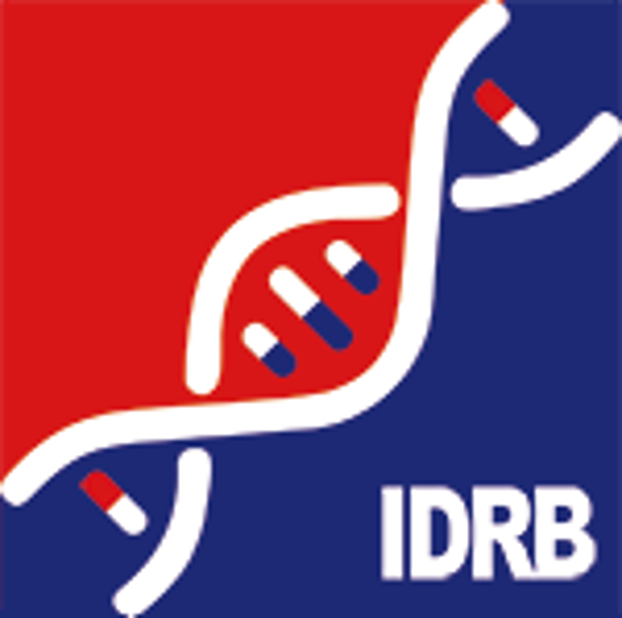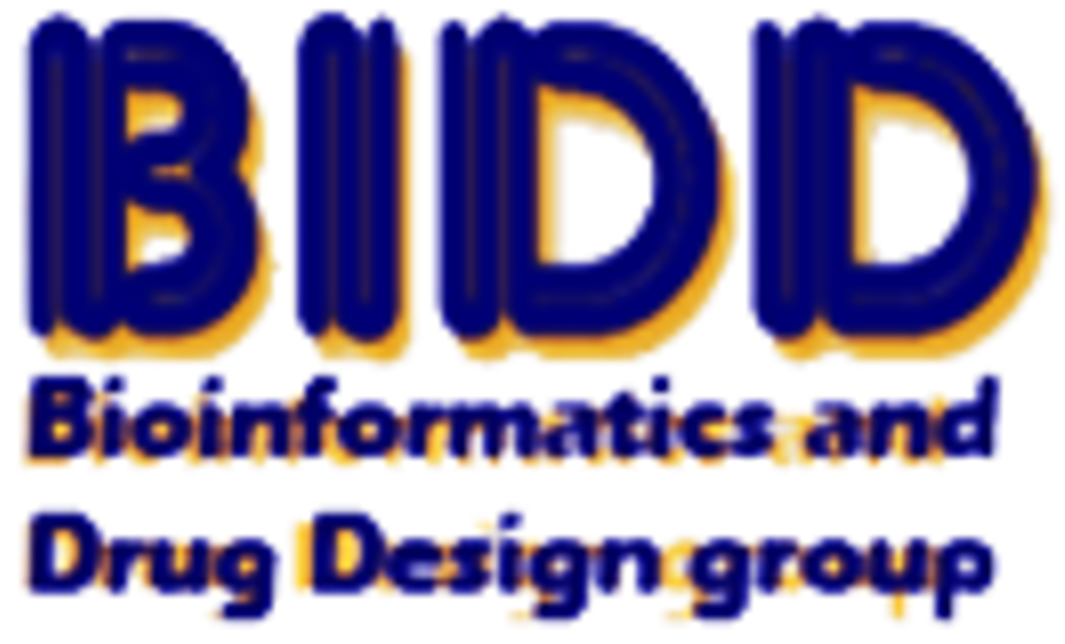Target Information
| Target General Information | Top | |||||
|---|---|---|---|---|---|---|
| Target ID |
T64553
(Former ID: TTDI02371)
|
|||||
| Target Name |
Tyrosine-protein kinase ZAP-70 (ZAP-70)
|
|||||
| Synonyms |
Syk-related tyrosine kinase; SRK; 70 kDa zeta-chain associated protein
Click to Show/Hide
|
|||||
| Gene Name |
ZAP70
|
|||||
| Target Type |
Patented-recorded target
|
[1] | ||||
| Function |
Regulates motility, adhesion and cytokine expression of mature T-cells, as well as thymocyte development. Contributes also to the development and activation of primary B-lymphocytes. When antigen presenting cells (APC) activate T-cell receptor (TCR), a serie of phosphorylations lead to the recruitment of ZAP70 to the doubly phosphorylated TCR component CD247/CD3Z through ITAM motif at the plasma membrane. This recruitment serves to localization to the stimulated TCR and to relieve its autoinhibited conformation. Release of ZAP70 active conformation is further stabilized by phosphorylation mediated by LCK. Subsequently, ZAP70 phosphorylates at least 2 essential adapter proteins: LAT and LCP2. In turn, a large number of signaling molecules are recruited and ultimately lead to lymphokine production, T-cell proliferation and differentiation. Furthermore, ZAP70 controls cytoskeleton modifications, adhesion and mobility of T-lymphocytes, thus ensuring correct delivery of effectors to the APC. ZAP70 is also required for TCR-CD247/CD3Z internalization and degradation through interaction with the E3 ubiquitin-protein ligase CBL and adapter proteins SLA and SLA2. Thus, ZAP70 regulates both T-cell activation switch on and switch off by modulating TCR expression at the T-cell surface. During thymocyte development, ZAP70 promotes survival and cell-cycle progression of developing thymocytes before positive selection (when cells are still CD4/CD8 double negative). Additionally, ZAP70-dependent signaling pathway may also contribute to primary B-cells formation and activation through B-cell receptor (BCR). Tyrosine kinase that plays an essential role in regulation of the adaptive immune response.
Click to Show/Hide
|
|||||
| BioChemical Class |
Kinase
|
|||||
| UniProt ID | ||||||
| EC Number |
EC 2.7.10.2
|
|||||
| Sequence |
MPDPAAHLPFFYGSISRAEAEEHLKLAGMADGLFLLRQCLRSLGGYVLSLVHDVRFHHFP
IERQLNGTYAIAGGKAHCGPAELCEFYSRDPDGLPCNLRKPCNRPSGLEPQPGVFDCLRD AMVRDYVRQTWKLEGEALEQAIISQAPQVEKLIATTAHERMPWYHSSLTREEAERKLYSG AQTDGKFLLRPRKEQGTYALSLIYGKTVYHYLISQDKAGKYCIPEGTKFDTLWQLVEYLK LKADGLIYCLKEACPNSSASNASGAAAPTLPAHPSTLTHPQRRIDTLNSDGYTPEPARIT SPDKPRPMPMDTSVYESPYSDPEELKDKKLFLKRDNLLIADIELGCGNFGSVRQGVYRMR KKQIDVAIKVLKQGTEKADTEEMMREAQIMHQLDNPYIVRLIGVCQAEALMLVMEMAGGG PLHKFLVGKREEIPVSNVAELLHQVSMGMKYLEEKNFVHRDLAARNVLLVNRHYAKISDF GLSKALGADDSYYTARSAGKWPLKWYAPECINFRKFSSRSDVWSYGVTMWEALSYGQKPY KKMKGPEVMAFIEQGKRMECPPECPPELYALMSDCWIYKWEDRPDFLTVEQRMRACYYSL ASKVEGPPGSTQKAEAACA Click to Show/Hide
|
|||||
| 3D Structure | Click to Show 3D Structure of This Target | PDB | ||||
| Cell-based Target Expression Variations | Top | |||||
|---|---|---|---|---|---|---|
| Cell-based Target Expression Variations | ||||||
| Drug Binding Sites of Target | Top | |||||
|---|---|---|---|---|---|---|
| Ligand Name: AMP-PNP | Ligand Info | |||||
| Structure Description | Autoinhibited intact human ZAP-70 | PDB:2OZO | ||||
| Method | X-ray diffraction | Resolution | 2.60 Å | Mutation | Yes | [4] |
| PDB Sequence |
PDPAAHLPFF
11 YGSISRAEAE21 EHLKLAGMAD31 GLFLLRQCLR41 SLGGYVLSLV51 HDVRFHHFPI 61 ERQLNGTYAI71 AGGKAHCGPA81 ELCEFYSRDP91 DGLPCNLRKP101 CNRPSGLEPQ 111 PGVFDCLRDA121 MVRDYVRQTW131 KLEGEALEQA141 IISQAPQVEK151 LIATTAHERM 161 PWYHSSLTRE171 EAERKLYSGA181 QTDGKFLLRP191 RKEQGTYALS201 LIYGKTVYHY 211 LISQDKAGKY221 CIPEGTKFDT231 LWQLVEYLKL241 KADGLIYCLK251 EACPNMDTSV 314 FESPFSDPEE324 LKDKKLFLKR334 DNLLIADIEL344 GCGNFGSVRQ354 GVYRMRKKQI 364 DVAIKVLKQG374 TEKADTEEMM384 REAQIMHQLD394 NPYIVRLIGV404 CQAEALMLVM 414 EMAGGGPLHK424 FLVGKREEIP434 VSNVAELLHQ444 VSMGMKYLEE454 KNFVHRNLAA 464 RNVLLVNRHY474 AKISDFGLSK484 ALGPLKWYAP508 ECINFRKFSS518 RSDVWSYGVT 528 MWEALSYGQK538 PYKKMKGPEV548 MAFIEQGKRM558 ECPPECPPEL568 YALMSDCWIY 578 KWEDRPDFLT588 VEQRMRACYY598 SLASKVEGGS608 ALEVA
|
|||||
|
|
LEU344
3.402
GLY345
4.302
CYS346
3.629
GLY347
3.282
ASN348
3.087
PHE349
3.524
GLY350
4.218
VAL352
3.567
ALA367
3.315
LYS369
3.180
VAL399
4.035
MET414
3.900
GLU415
3.000
|
|||||
| Click to View More Binding Site Information of This Target and Ligand Pair | ||||||
| Ligand Name: Staurosporine | Ligand Info | |||||
| Structure Description | Crystal Structure of the ZAP-70 Kinase Domain in Complex with Staurosporine | PDB:1U59 | ||||
| Method | X-ray diffraction | Resolution | 2.30 Å | Mutation | No | [5] |
| PDB Sequence |
KKLFLKRDNL
337 LIADIELGCG347 NFGSVRQGVY357 RKQIDVAIKV370 LKQGTEKADT380 EEMMREAQIM 390 HQLDNPYIVR400 LIGVCQAEAL410 MLVMEMAGGG420 PLHKFLVGKR430 EEIPVSNVAE 440 LLHQVSMGMK450 YLEEKNFVHR460 DLAARNVLLV470 NRHYAKISDF480 GLSKALGADD 490 SYYTARSAGK500 WPLKWYAPEC510 INFRKFSSRS520 DVWSYGVTMW530 EALSYGQKPY 540 KKMKGPEVMA550 FIEQGKRMEC560 PPECPPELYA570 LMSDCWIYKW580 EDRPDFLTVE 590 QRMRACYYSL600 ASKVEGHHHH610 HH
|
|||||
|
|
LEU344
3.235
GLY345
3.336
CYS346
4.099
PHE349
4.555
VAL352
3.637
ALA367
3.237
LYS369
4.185
GLU386
4.247
VAL399
4.036
MET414
3.614
GLU415
2.949
|
|||||
| Click to View More Binding Site Information of This Target with Different Ligands | ||||||
| Different Human System Profiles of Target | Top |
|---|---|
|
Human Similarity Proteins
of target is determined by comparing the sequence similarity of all human proteins with the target based on BLAST. The similarity proteins for a target are defined as the proteins with E-value < 0.005 and outside the protein families of the target.
A target that has fewer human similarity proteins outside its family is commonly regarded to possess a greater capacity to avoid undesired interactions and thus increase the possibility of finding successful drugs
(Brief Bioinform, 21: 649-662, 2020).
Human Tissue Distribution
of target is determined from a proteomics study that quantified more than 12,000 genes across 32 normal human tissues. Tissue Specificity (TS) score was used to define the enrichment of target across tissues.
The distribution of targets among different tissues or organs need to be taken into consideration when assessing the target druggability, as it is generally accepted that the wider the target distribution, the greater the concern over potential adverse effects
(Nat Rev Drug Discov, 20: 64-81, 2021).
Human Pathway Affiliation
of target is determined by the life-essential pathways provided on KEGG database. The target-affiliated pathways were defined based on the following two criteria (a) the pathways of the studied target should be life-essential for both healthy individuals and patients, and (b) the studied target should occupy an upstream position in the pathways and therefore had the ability to regulate biological function.
Targets involved in a fewer pathways have greater likelihood to be successfully developed, while those associated with more human pathways increase the chance of undesirable interferences with other human processes
(Pharmacol Rev, 58: 259-279, 2006).
Biological Network Descriptors
of target is determined based on a human protein-protein interactions (PPI) network consisting of 9,309 proteins and 52,713 PPIs, which were with a high confidence score of ≥ 0.95 collected from STRING database.
The network properties of targets based on protein-protein interactions (PPIs) have been widely adopted for the assessment of target’s druggability. Proteins with high node degree tend to have a high impact on network function through multiple interactions, while proteins with high betweenness centrality are regarded to be central for communication in interaction networks and regulate the flow of signaling information
(Front Pharmacol, 9, 1245, 2018;
Curr Opin Struct Biol. 44:134-142, 2017).
Human Similarity Proteins
Human Tissue Distribution
Human Pathway Affiliation
Biological Network Descriptors
|
|
|
Note:
If a protein has TS (tissue specficity) scores at least in one tissue >= 2.5, this protein is called tissue-enriched (including tissue-enriched-but-not-specific and tissue-specific). In the plots, the vertical lines are at thresholds 2.5 and 4.
|
| KEGG Pathway | Pathway ID | Affiliated Target | Pathway Map |
|---|---|---|---|
| Ras signaling pathway | hsa04014 | Affiliated Target |

|
| Class: Environmental Information Processing => Signal transduction | Pathway Hierarchy | ||
| NF-kappa B signaling pathway | hsa04064 | Affiliated Target |
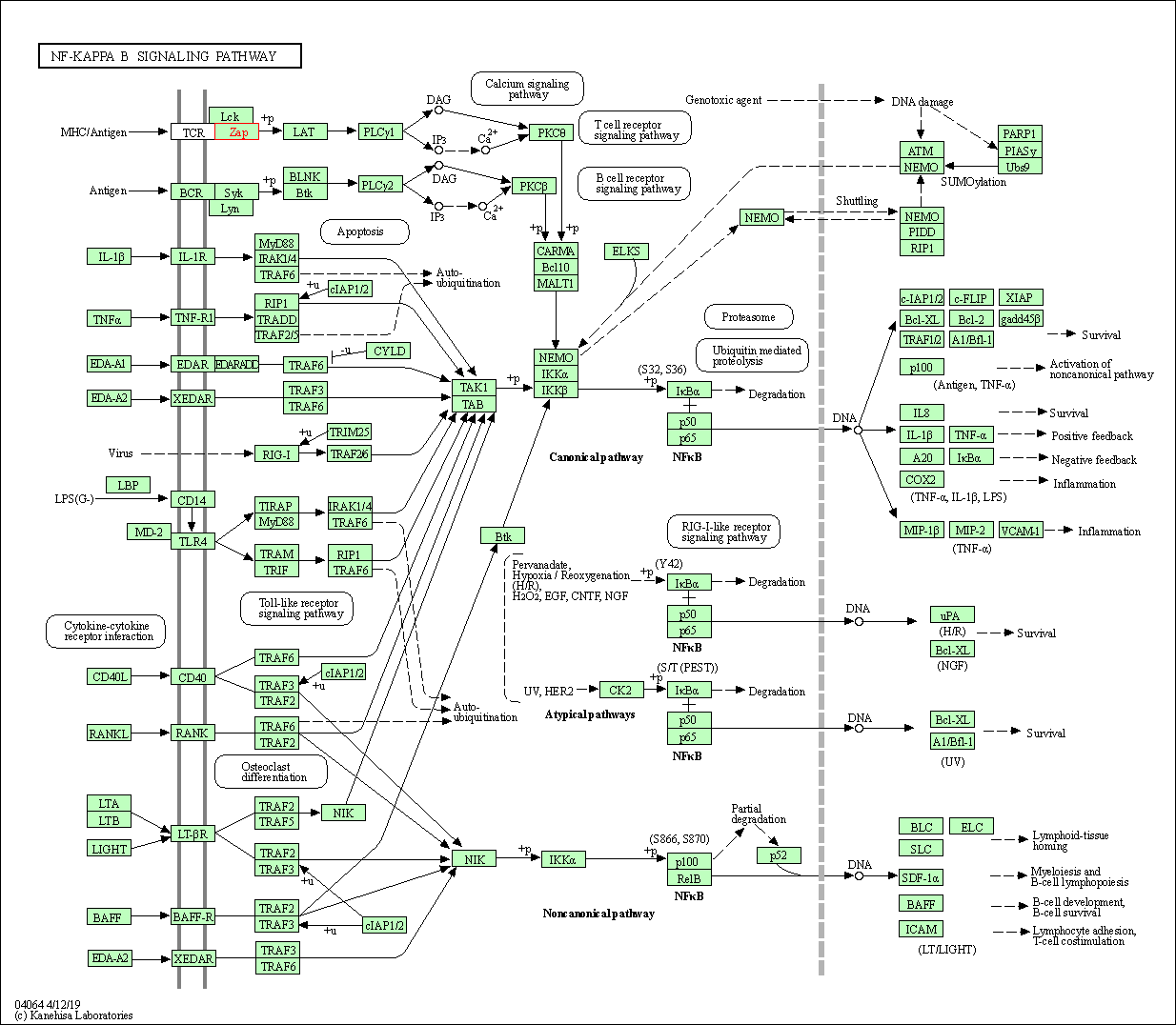
|
| Class: Environmental Information Processing => Signal transduction | Pathway Hierarchy | ||
| Natural killer cell mediated cytotoxicity | hsa04650 | Affiliated Target |

|
| Class: Organismal Systems => Immune system | Pathway Hierarchy | ||
| Th1 and Th2 cell differentiation | hsa04658 | Affiliated Target |
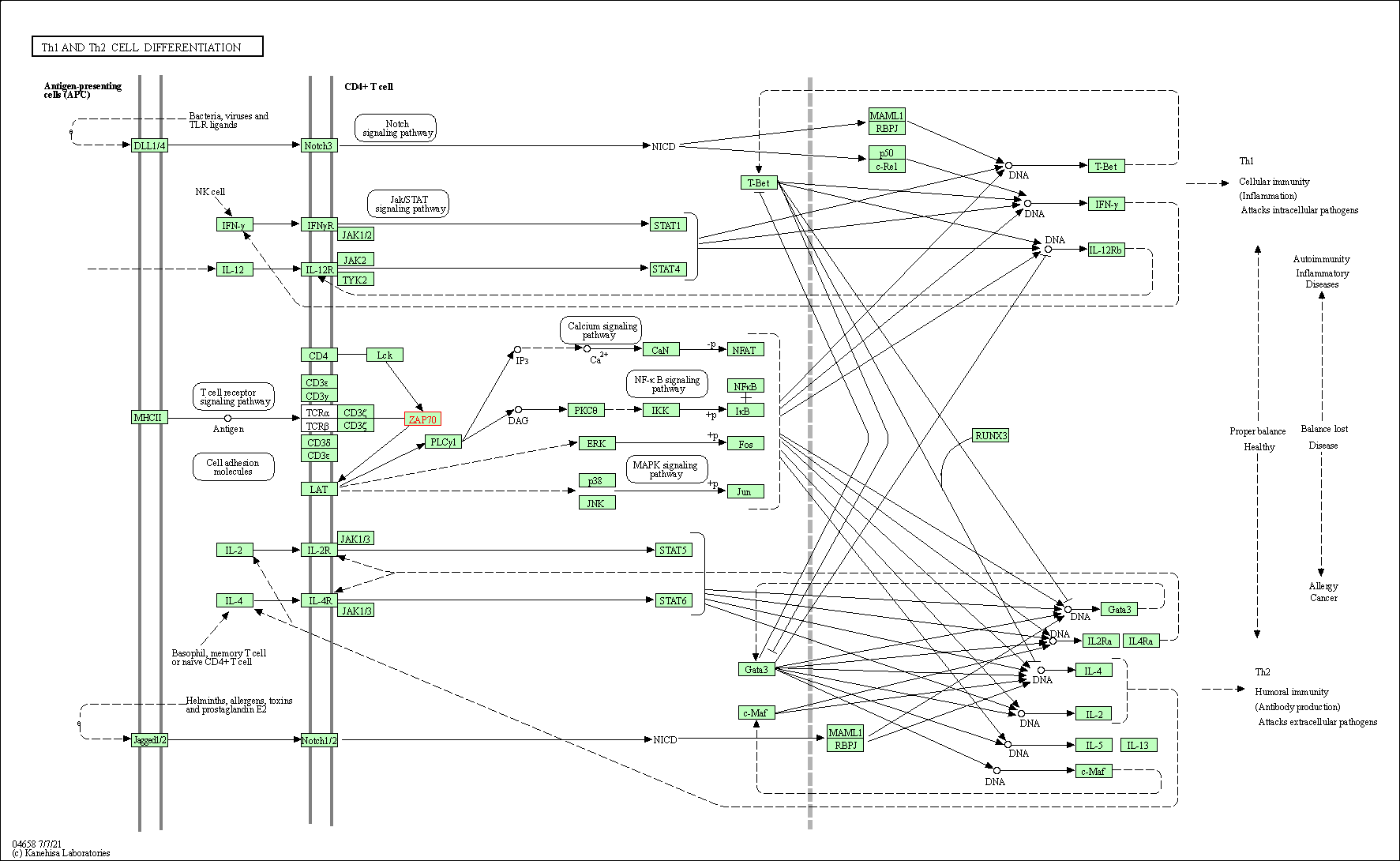
|
| Class: Organismal Systems => Immune system | Pathway Hierarchy | ||
| Th17 cell differentiation | hsa04659 | Affiliated Target |

|
| Class: Organismal Systems => Immune system | Pathway Hierarchy | ||
| T cell receptor signaling pathway | hsa04660 | Affiliated Target |
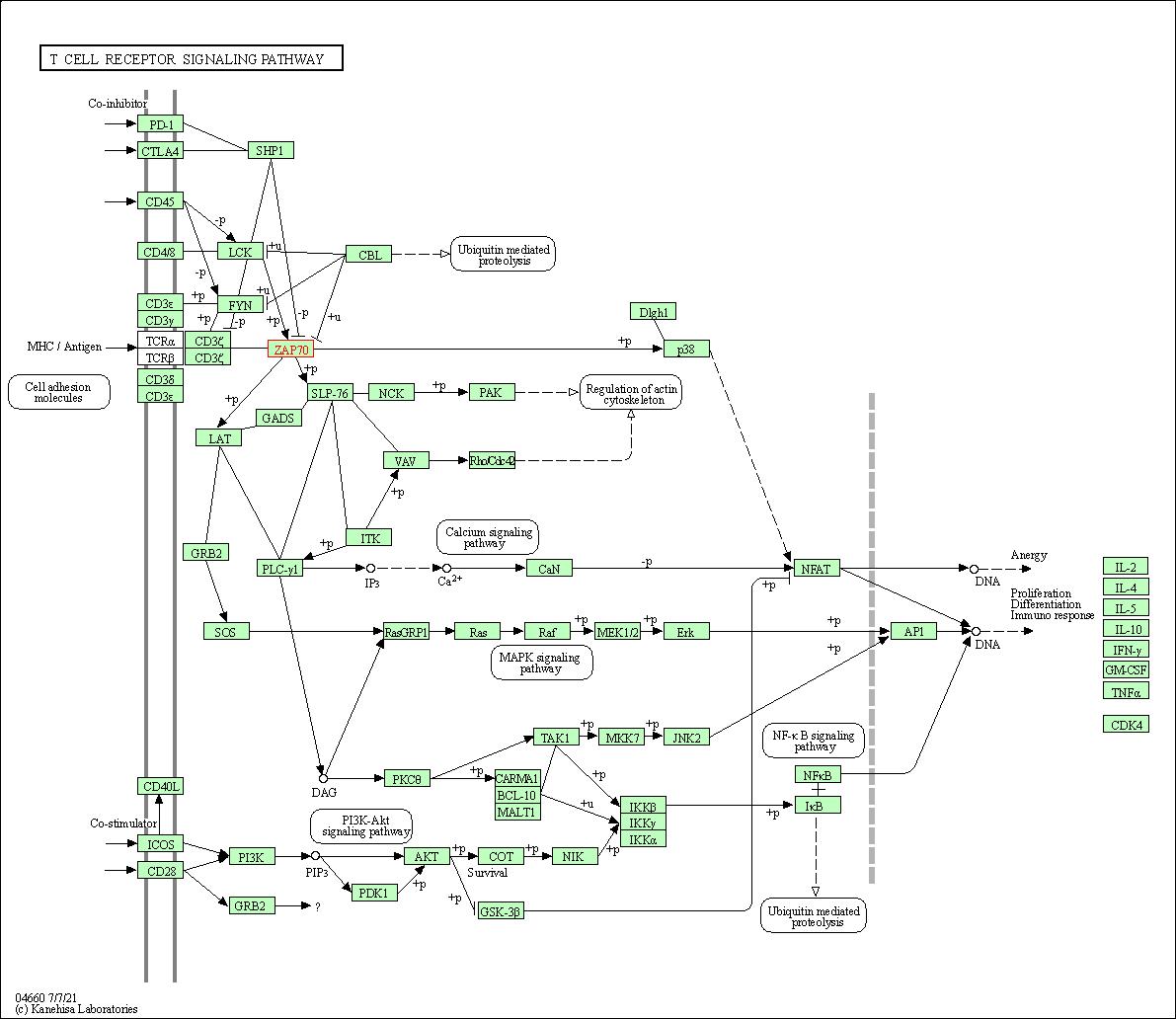
|
| Class: Organismal Systems => Immune system | Pathway Hierarchy | ||
| Click to Show/Hide the Information of Affiliated Human Pathways | |||
| Degree | 30 | Degree centrality | 3.22E-03 | Betweenness centrality | 6.46E-04 |
|---|---|---|---|---|---|
| Closeness centrality | 2.23E-01 | Radiality | 1.39E+01 | Clustering coefficient | 2.62E-01 |
| Neighborhood connectivity | 2.61E+01 | Topological coefficient | 8.70E-02 | Eccentricity | 12 |
| Download | Click to Download the Full PPI Network of This Target | ||||
| Chemical Structure based Activity Landscape of Target | Top |
|---|---|
| Drug Property Profile of Target | Top | |
|---|---|---|
| (1) Molecular Weight (mw) based Drug Clustering | (2) Octanol/Water Partition Coefficient (xlogp) based Drug Clustering | |
|
|
||
| (3) Hydrogen Bond Donor Count (hbonddonor) based Drug Clustering | (4) Hydrogen Bond Acceptor Count (hbondacc) based Drug Clustering | |
|
|
||
| (5) Rotatable Bond Count (rotbonds) based Drug Clustering | (6) Topological Polar Surface Area (polararea) based Drug Clustering | |
|
|
||
| "RO5" indicates the cutoff set by lipinski's rule of five; "D123AB" colored in GREEN denotes the no violation of any cutoff in lipinski's rule of five; "D123AB" colored in PURPLE refers to the violation of only one cutoff in lipinski's rule of five; "D123AB" colored in BLACK represents the violation of more than one cutoffs in lipinski's rule of five | ||
| Target Poor or Non Binders | Top | |||||
|---|---|---|---|---|---|---|
| Target Poor or Non Binders | ||||||
| Target Regulators | Top | |||||
|---|---|---|---|---|---|---|
| Target-regulating microRNAs | ||||||
| Target-interacting Proteins | ||||||
| Target Affiliated Biological Pathways | Top | |||||
|---|---|---|---|---|---|---|
| KEGG Pathway | [+] 5 KEGG Pathways | + | ||||
| 1 | Ras signaling pathway | |||||
| 2 | NF-kappa B signaling pathway | |||||
| 3 | Natural killer cell mediated cytotoxicity | |||||
| 4 | T cell receptor signaling pathway | |||||
| 5 | Primary immunodeficiency | |||||
| Panther Pathway | [+] 1 Panther Pathways | + | ||||
| 1 | T cell activation | |||||
| PID Pathway | [+] 5 PID Pathways | + | ||||
| 1 | TCR signaling in naï | |||||
| 2 | ||||||
| 3 | TCR signaling in naï | |||||
| 4 | ||||||
| 5 | Class I PI3K signaling events | |||||
| Reactome | [+] 2 Reactome Pathways | + | ||||
| 1 | Translocation of ZAP-70 to Immunological synapse | |||||
| 2 | Generation of second messenger molecules | |||||
| WikiPathways | [+] 6 WikiPathways | + | ||||
| 1 | TCR Signaling Pathway | |||||
| 2 | Interferon type I signaling pathways | |||||
| 3 | Inflammatory Response Pathway | |||||
| 4 | JAK/STAT | |||||
| 5 | T-Cell Receptor and Co-stimulatory Signaling | |||||
| 6 | TCR signaling | |||||
| References | Top | |||||
|---|---|---|---|---|---|---|
| REF 1 | Synthetic studies on novel Syk inhibitors. Part 1: Synthesis and structure-activity relationships of pyrimidine-5-carboxamide derivatives. Bioorg Med Chem. 2005 Aug 15;13(16):4936-51. | |||||
| REF 2 | Compounds and compositions as kinase inhibitors. US8546370. | |||||
| REF 3 | Identification of binding specificity-determining features in protein families. J Med Chem. 2012 Mar 8;55(5):1926-39. | |||||
| REF 4 | Structural basis for the inhibition of tyrosine kinase activity of ZAP-70. Cell. 2007 May 18;129(4):735-46. | |||||
| REF 5 | The three-dimensional structure of the ZAP-70 kinase domain in complex with staurosporine: implications for the design of selective inhibitors. J Biol Chem. 2004 Oct 8;279(41):42818-25. | |||||
If You Find Any Error in Data or Bug in Web Service, Please Kindly Report It to Dr. Zhou and Dr. Zhang.
